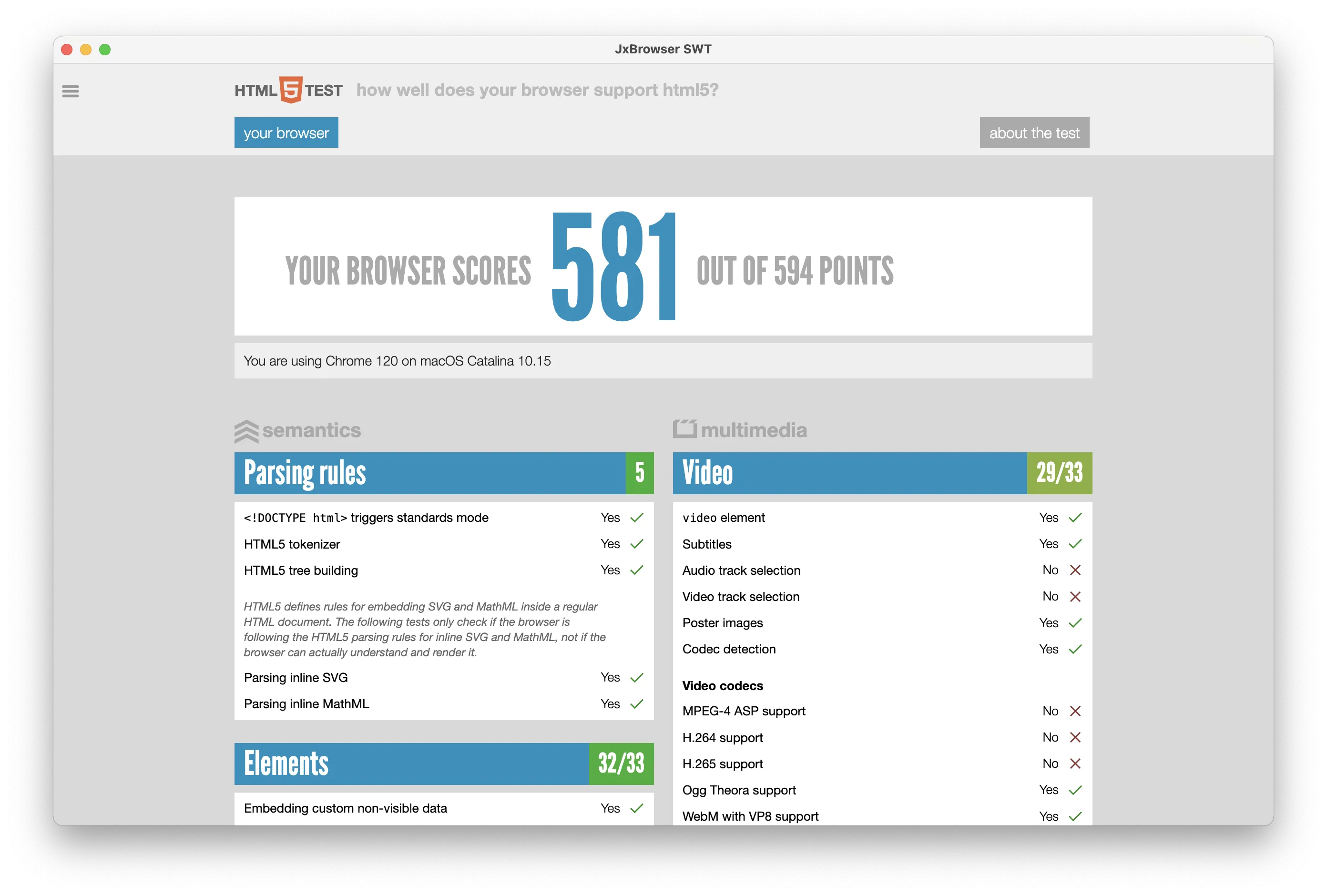JxBrowser in SWT
The easiest way to start working with JxBrowser in an SWT Gradle project is to clone the GitHub repository where everything is already set up and ready to go.
Prerequisites
- Git.
- Java 8.
- JxBrowser license key, or a free 30-day evaluation key.
Getting the project
Clone the GitHub repository using the following command:
git clone https://github.com/TeamDev-IP/JxBrowser-QuickStart-Gradle-SWT.git
git checkout v7
cd JxBrowser-QuickStart-Gradle-SWT
Run the SWT application
Use the following command to build and run SWT application:
./gradlew run -Djxbrowser.license.key=<your_license_key>
Once launched, you will see an SWT application with a BrowserView component displaying https://html5test.teamdev.com:

Project overview
This section explains how the Gradle project is configured to include JxBrowser and
how a JxBrowser BrowserView component is embedded into an SWT shell to display content of the loaded web page.
Configuring the Gradle project
The Gradle project uses the JxBrowser Gradle plugin to add the necessary JxBrowser dependencies and fetch the Chromium binaries for the current platform.
Here’s how the build.gradle.kts file is configured:
import org.apache.tools.ant.taskdefs.condition.Os
import org.apache.tools.ant.taskdefs.condition.Os.FAMILY_MAC
plugins {
java
application
kotlin("jvm") version "2.0.0"
// Allows adding JxBrowser dependencies.
id("com.teamdev.jxbrowser") version "1.2.1"
}
repositories {
mavenCentral()
}
jxbrowser {
// Use the latest stable JxBrowser version.
version = "7.44.2"
}
dependencies {
// Detects the current platform and adds the corresponding Chromium binaries.
implementation(jxbrowser.currentPlatform)
// Adds dependency to the SWT UI toolkit integration.
implementation(jxbrowser.swt)
// Adds the platform-specific SWT dependencies.
implementation(Swt.toolkitDependency)
}
Swt.configurePlatformDependency(project)
application {
// Define the main class for the application.
mainClass.set("com.teamdev.jxbrowser.quickstart.gradle.swt.App")
// Define the main class for the Kotlin application.
// mainClass.set("com.teamdev.jxbrowser.quickstart.gradle.swt.AppKt")
}
tasks.withType<JavaExec> {
if (Os.isFamily(FAMILY_MAC)) {
jvmArgs(
// For macOS to run SWT under Cocoa.
"-XstartOnFirstThread"
)
}
// Assign all Java system properties from the command line to
// the JavaExec task to pass the JxBrowser license key.
systemProperties(System.getProperties().mapKeys { it.key as String })
}
Embedding JxBrowser into SWT
There are two SWT app implementations in the project: Java and Kotlin.
Both implementations are similar and demonstrate how to:
- Initialize an engine (Chromium) instance.
- Create a browser instance.
- Load the required web page.
- Embed a
BrowserViewcomponent into an SWT shell to display the loaded web page.
import static com.teamdev.jxbrowser.engine.RenderingMode.HARDWARE_ACCELERATED;
import com.teamdev.jxbrowser.browser.Browser;
import com.teamdev.jxbrowser.engine.Engine;
import com.teamdev.jxbrowser.view.swt.BrowserView;
import org.eclipse.swt.layout.FillLayout;
import org.eclipse.swt.widgets.Display;
import org.eclipse.swt.widgets.Shell;
public final class App {
public static void main(String[] args) {
// Initialize Chromium.
Engine engine = Engine.newInstance(HARDWARE_ACCELERATED);
// Create a Browser instance.
Browser browser = engine.newBrowser();
// Load the required web page.
browser.navigation().loadUrl("https://html5test.teamdev.com");
Display display = new Display();
Shell shell = new Shell(display);
shell.setText("JxBrowser SWT");
shell.setLayout(new FillLayout());
// Create and embed SWT BrowserView widget to display web content.
BrowserView view = BrowserView.newInstance(shell, browser);
view.setSize(1280, 800);
shell.pack();
shell.open();
while (!shell.isDisposed()) {
if (!display.readAndDispatch()) {
display.sleep();
}
}
// Shutdown Chromium and release allocated resources.
engine.close();
display.dispose();
}
}
import com.teamdev.jxbrowser.engine.Engine
import com.teamdev.jxbrowser.engine.RenderingMode.HARDWARE_ACCELERATED
import com.teamdev.jxbrowser.view.swt.BrowserView
import org.eclipse.swt.layout.FillLayout
import org.eclipse.swt.widgets.Display
import org.eclipse.swt.widgets.Shell
fun main() {
// Initialize Chromium.
val engine = Engine.newInstance(HARDWARE_ACCELERATED)
// Create a Browser instance.
val browser = engine.newBrowser()
// Load the required web page.
browser.navigation().loadUrl("https://html5test.teamdev.com")
val display = Display()
val shell = Shell(display)
shell.text = "JxBrowser SWT"
shell.layout = FillLayout()
// Create and embed SWT BrowserView widget to display web content.
val view = BrowserView.newInstance(shell, browser)
view.setSize(1280, 800)
shell.pack()
shell.open()
while (!shell.isDisposed) {
if (!display.readAndDispatch()) {
display.sleep()
}
}
// Shutdown Chromium and release allocated resources.
engine.close()
display.dispose()
}
What’s next
- Learn more how to add JxBrowser to a Gradle project.
- Read about how to embed JxBrowser into an SWT app.
- Discover all JxBrowser features by checking out our guides.